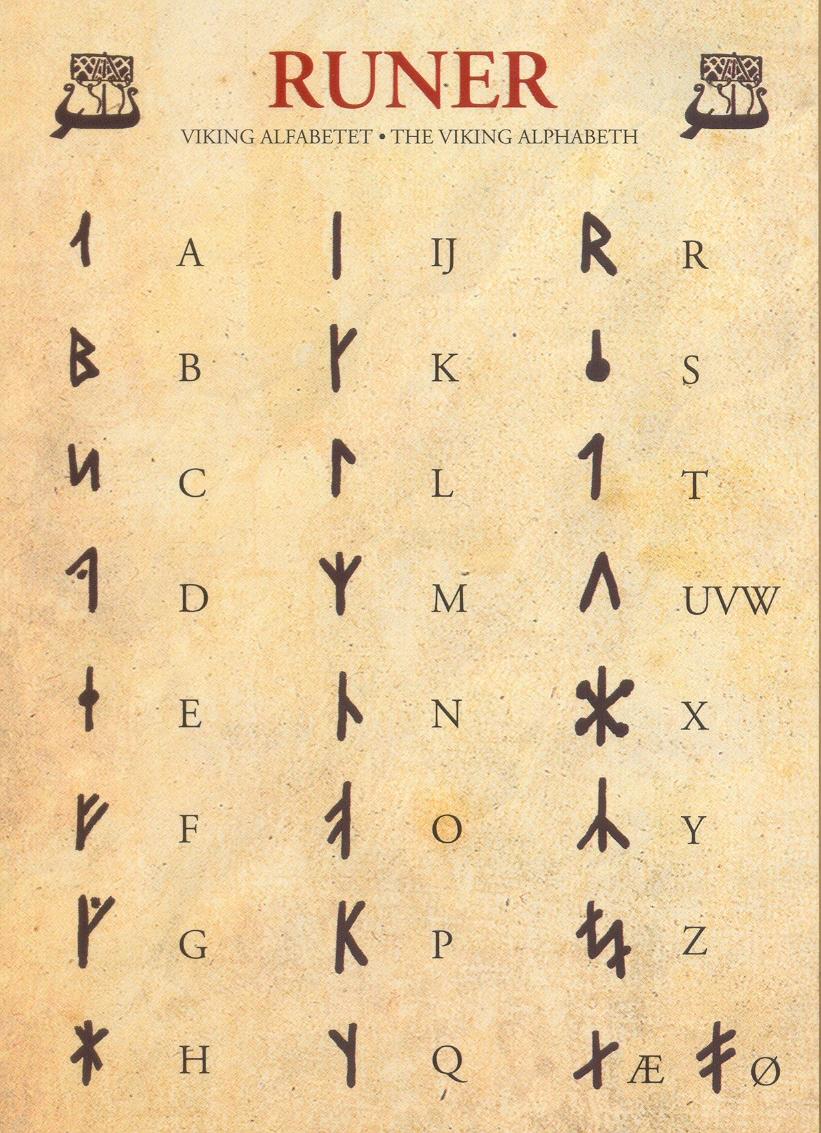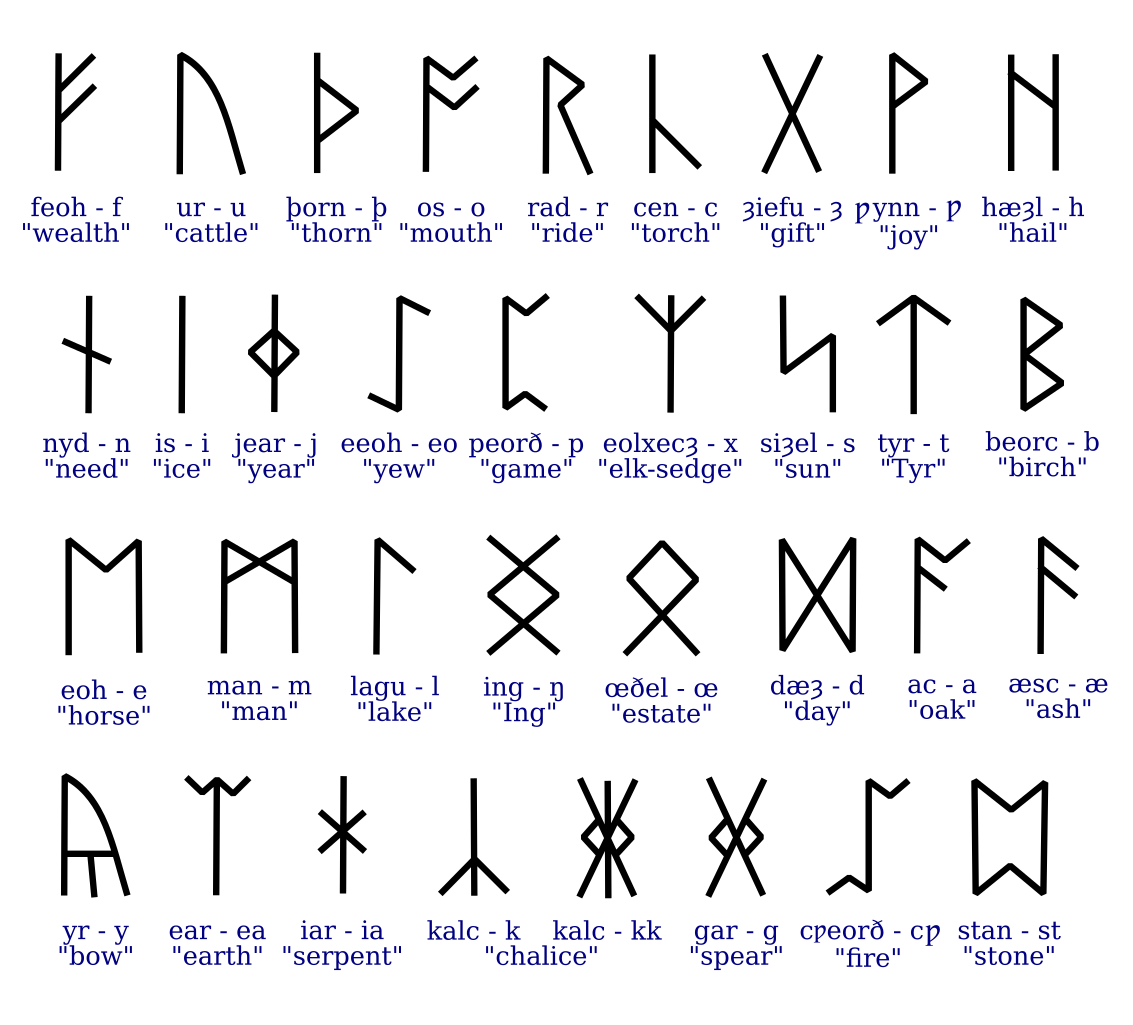Year 4 Runes...the Anglosaxon alphabets
The three best-known runic alphabets are the Elder Futhark ( c. AD 150-800), the Anglo-Saxon Futhorc (400-1100), and the Younger Futhark (800-1100).

Anglo Saxon Alphabet, Anglo Saxon Runes, Celtic Runes, Ancient Runes, Viking Symbols, Viking
The runic alphabet used by the people of northwest Europe for more than a thousand years contains two great mysteries.. Elder Futhark is the ancestor of Anglo-Saxon runes, and also of the 16.

Northumbrian (latest AngloSaxon) runes.. Image 1 Anglo saxon tattoo, Anglo saxon runes, Runes
The Anglo-Saxon Futhorc, or alphabet, is a set of runes which were used as a writing system before the adoption of the Latin alphabet. The characters are formed from straight lines to make them easier to carve into wood, or occasionally metal or stone; ink and parchment were not generally used for writing before the arrival of the Christian Church.

Pin on ANS Website Blog
What culture are runes from? What language are Viking runes (Old Norse runes) written in? How vital are runes in Norse Mythology? What are Elder Futhark Runes? The Runic alphabet and meaning behind each symbol Freyr's aett Hagalaz's aett Tyr and Ziza's aett Are runes read left to right? Are Celtic and Nordic runes the same?

Pin on ANS Website Blog
Anglo-Saxon runes has its origins in the older Futhark, but enjoys further in Friesland in the current North-West Germany, where Saxons lived 400 years before they immigrants and occupied the British Isles.. In the Nordic / Germanic runic alphabet is the first 5 runes fuþark, but the first 5 runes in the Anglo-Saxon runic alphabet is fuþorc .

Pin on ANS Website Blog
Anglo-Saxon Futhorc Younger Futhork Hungarian Runes (Székely Rovásírás) Turkic (Orkhon) Runes Cirth (Tolkein's Runic-like alphabet) Elder Futhark Elder Futhark is thought to be the oldest version of the Runic alphabet, and was used in the parts of Europe which were home to Germanic peoples, including Scandinavia.

My Picture Postcards Viking Alphabet Runic alphabet
The runic alphabet used to write Old English before the introduction of the Latin alphabet. Old English was first written in runes, using the futhorc—a rune set derived from the Germanic 24-character elder futhark, extended by five more runes used to represent Anglo-Saxon vowel sounds and sometimes by several more additional characters.

AngloSaxon Futhorc Anglo saxon runes, Anglo saxon tattoo, Runic alphabet
Anglo-Saxon ᚻᛖᛚᛚᚩ × ᛘᛁᛞᚷᚪᚱᛞ Runes to text ᚨᛚᚢ → ALU Want to translate a runic text to a latin alphabet instead? Then check out the rune translator! It has a ready made keyboard with the known runes which you can type or paste in a text to convert it to latin letters Rune translator Good to know about the runes Learn The Runes

The AngloSaxon runes which are known as futhorc. They remained in use in AngloSaxon England
The Rune Converter transforms Roman alphabet, as used in modern English, into five systems of Germanic runic writing: Elder Futhark, Anglo-Saxon runes, Long Branch Younger Futhark, Short Twig Younger Futhark and staveless runes (note that it does not translate the words themselves, it only converts letters into runes).

The Secret Guide To Saxon Alphabet Chart Kids Fun Actitvy
The Anglo-Saxon script added letters to the futhark to represent sounds of Old English that did not occur in the languages that had used the Early Germanic script. Anglo-Saxon had 28 letters, and after about 900 ad it had 33. There were also some slight differences in letter shape.

Pin on History
Runes were a form of writing used across Northern Europe during the early Middle Ages - the time of the Anglo-Saxons and Vikings. Tolkien adapts a few of the real signs and gives a key to translating them. It is important to point out that runes have NO connection with the occult, with witchcraft, or necessarily with paganism.

AngloSaxon Runes Ancient alphabets, Anglo saxon runes, Rune alphabet
Anglo-Saxon runes are an extended version of Elder Futhark consisting of between 26 and 33 letters. It is thought that they were used to write Old English / Anglo-Saxon and Old Frisian from about the 5th century AD.

FileAnglosaxonrunes.svg Wikipedia
(b) a > æ when not followed by a nasal consonant; (c) Gmc. *ai > OE ā; Gmc. *au > OFris. ā. A good example of these changes is the name Oswald, the first element of which (ōs-), due to nasalization, reflects the common Germanic *ans-, found in the name of the *ansuz rune.

AngloSaxon Runes font
Anglo-Saxon runes (futhorc/fuþorc) Old English / Anglo-Saxon was first written with a version of the Runic alphabet known as Anglo-Saxon or Anglo-Frisian runes, or futhorc/fuþorc. This alphabet was an extended version of Elder Futhark with between 26 and 33 letters.

AngloSaxon Runes.
ᚠ ᚢ ᚦ ᚨ ᚱ ᚲ ᚷ ᚹ ᚺ ᚾ ᛁ ᛃ ᛈ ᛇ ᛉ ᛊ ᛏ ᛒ ᛖ ᛗ ᛚ ᛜ ᛞ ᛟ SPACE Text to runes ALU → ᚨᛚᚢ Want to translate a regular text into runes instead? Then check out the rune converter! It currently features three futharks - elder, younger, anglo-saxon and can be used to turn text into either of those Rune converter Good to know about the runes Learn The Runes

Pin by Tiffany Hembree on Witchery Anglo saxon runes, Runes, Anglo saxon
This teacher-made Anglo-Saxon runes worksheet has been designed to supplement your lessons on Anglo-Saxons and their language in your KS2 class. Show more Related Searches anglo saxons runes anglo saxon anglo saxons ks2 anglo saxon craft ideas viking runes Ratings & Reviews Curriculum Links Make a Request Resource Updates